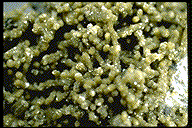

- Chemistry: Cu19(NO3)2Cl4(OH)32 - 2H2O, Hydrated Copper Nitrate Chloride Hydroxide.
- Class: Carbonates.
- Subclass: Nitrates.
- Uses: As a very minor ore of copper and as mineral specimens.
Specimens
Buttgenbachite is much rarer than connellite.
It was first discovered at Likasi,
PHYSICAL CHARACTERISTICS:
- Color is deep blue.
- Luster is vitreous.
- Transparency: Specimens are translucent to transparent.
- Crystal System is hexagonal; 6 2 2.
- Crystal Habits include acicular to fibrous crystals arranged in tufts, layers or radial aggregates.
- Cleavage is absent.
- Fracture is uneven.
- Hardness is 3
- Specific Gravity is approximately 3.4 - 3.5 (slightly above average for non-metallic minerals).
- Streak is blue.
- Associated Minerals include quartz and copper minerals.
- Notable Occurrence is limited to the Likasi,
Shaba , now of the Congo and South Comobabi Mountains, Pima County, Arizona, USA. - Best Field Indicators are crystal habit, color, associations and locality.








